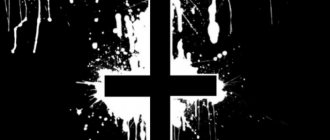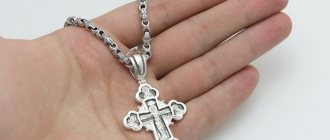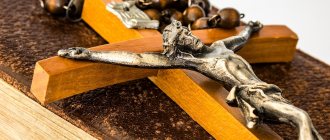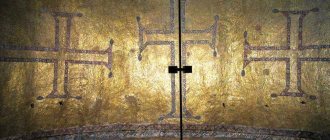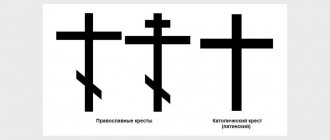From the history of the flourishing cross
Flourishing crosses in different versions of their depiction - from the extremely conventional to the naturalistic - are found in Christian art of almost all countries and eras.
Variations of the flourishing cross appeared in early Christian art, and then in Byzantium, and passed from there to different countries. For example, in the catacombs of Pontian (Rome, 6th century) an image of a cross has been preserved, the lower horn of which “bloomed” with small flowers directed upward at an angle.
Flourishing Cross
loved in Armenia
,
where it has virtually become a symbol of the national church; flourishing crosses are found in Georgian and Greek church art, as well as in Western Europe.
In Russian art, including small plastic arts, the cross has flourished since the first times of Christianity in Rus'. His image can also be seen in the decoration of temples. For example, the tomb of Grand Duke Yaroslav (11th century) in the St. Sophia Cathedral in Kiev is decorated with several images of a flourishing cross: in one case it is entwined with a vine covered with flowers and fruits, in another it has grown quite powerful trees from itself.
The cross flourished especially widely in Russian church art of the 17th century. This is no coincidence: it was in this century that Russian jewelers and icon painters most widely used a variety of Christian symbols, and church art became especially decorative. In this century, the image of the flourishing cross became especially magnificent. Bizarre growth surrounded the Tree of the Cross on all sides, “grew”, becoming magnificent and complex.
The flourishing cross is a piece of jewelry and a symbol of the Christian faith.
The pectoral cross is worn today as a fashionable piece of jewelry, although in reality this attribute has the deepest sacred meaning.
According to church canons, the pendant should be hidden under clothing, “closer to the body,” hence its name. The amulet is designed to constantly remind the owner of the torment that the Son of God endured when he ascended to Golgotha with a heavy cross on his shoulders. Orthodox jewelry is made from gold or silver not for beauty, but for reasons of durability and reliability, because noble metals are amorphous and are little susceptible to aggressive environmental influences. The Church allows that you can buy a pectoral cross in a jewelry store or online store, but the product must be consecrated and in shape comply with the requirements of the Christian tradition.
Symbolism of the flourishing cross
The idea of a flourishing cross
rooted in Holy Scripture and Orthodox worship. It goes back to the memory of the Tree of Life that grew in paradise. This memory, reflected in various traditions and legends, was characteristic of many peoples, including pagans.
But the main meaning of the flourishing cross is a reminder that both the heavenly bliss that believers strive for and the opportunity to be with God already in earthly life are the fruits of the Cross of Christ. The terrible instrument of execution “bloomed”, growing into a wondrous flower of Salvation.
Finally, any plant reminds us of the biblical image: “ Even if a grain of wheat falls on the ground and does not die, then one thing remains: but if it dies, it produces many fruits.”
"(John 12:24). This principle is the basis of the doctrine of salvation. The Lord died in order to resurrect humanity together with Himself. Each of us is called to put to death the sin within ourselves, which is often as painful as if you were dying yourself, but through this lies the path to the revival of the soul in God.
In liturgical texts the idea of a flourishing cross appears many times. « Prosper the Tree of the Cross
“- says the irmos of the canon for the Feast of the Exaltation of the Cross of the Lord.
“ I am the true Vine, and My Father is the Vinedresser;
Every branch of Me that does not bear fruit He cuts off; and every one that bears fruit he cleanses, that it may bear more fruit .
- Christ says in the Gospel, -... Abide in Me, and I in you.
Just as a branch cannot bear fruit by itself unless it is in the vine, so neither can you unless you are in Me. I am the vine, and you are the branches; He who abides in Me, and I in him, bears much fruit; for without Me you can do nothing. Whoever does not abide in Me will be cast out like a branch and wither ” (John 15:1-7).
Varieties of crosses
There are several traditional forms of Christian crosses:
- Latin, consisting of two crossbars of different lengths;
- four-pointed, or teardrop-shaped, decorated at the ends with drops, symbolizing the blood of Christ;
- six-pointed, with a diagonal arrangement of the lower crossbar;
- eight-pointed, presented in the form of three horizontal bars - for the arms, for the legs and a sign above the head.
But perhaps the most beautiful and magnificent type of Orthodox attribute is the curved cross, better known as the flourished one.
Origin, name in Armenian
The cross, which is revered by the Armenian people, has its own name - “haykakan khach”. It is known that it appeared not at the time of the emergence of Christianity, but much earlier. The ancestors of the Armenians depicted it in rock paintings several thousand years BC.
The Armenian cross can be seen on believers, in the holy places of the Apostolic Church, where it is given the most prominent place. This symbol is also present on numerous stone steles called khachkars. They are a special attraction of Armenia, ancient monuments found everywhere in this country.
SYMBOLICS OF THE ORTHODOX PATTERN CROSS
SYMBOLICS OF THE ORTHODOX PATTERN CROSS
Today we will talk about the history of wearing a cross on the chest. The custom of placing a pectoral cross on the neck of the newly baptized person along with Baptism did not appear immediately. In the first centuries of Christianity, they did not wear a cross, but rather wore medallions with the image of a slain Lamb or the Crucifixion. But the Cross, as the instrument of the salvation of the world by Jesus Christ, has been the subject of the greatest celebration among Christians from the very beginning of the Church. For example, the church thinker Tertullian (II–III centuries) in his “Apology” testifies that the veneration of the cross existed from the first times of Christianity. Even before the discovery of the life-giving Cross on which Christ was crucified in the 4th century by Queen Helena and Emperor Constantine, it was already common among the first followers of Christ to always have an image of the cross with them, and some Christians even depicted the figure of the cross on their foreheads - as a reminder about the sufferings of the Lord, and for confessing one’s faith before others.
The first documentary evidence of wearing crosses dates back to the beginning of the 4th century. Thus, the acts of the VII Ecumenical Council testify that the holy martyrs Orestes (†304) and Procopius (†303), who suffered under Diocletian, wore a cross made of gold and silver around their necks.
After the weakening and subsequent cessation of the persecution of Christians, wearing a cross became a widespread custom. At the same time, crosses began to be installed on all Christian churches. In Rus', this custom was adopted precisely with the baptism of the Slavs in 988. Since Byzantine times, there have been two types of body crosses in Rus': the “telniks” themselves (worn on the body under clothing) and the so-called “encolpions” (from the Greek word for “chest”), worn not on the body, but over clothing. Let's say two words about the last: initially, pious Christians carried with them (on themselves) a reliquary with particles of St. relics or other shrines. A cross was placed on this reliquary. Subsequently, the reliquary itself took on the shape of a cross, and bishops and emperors began to wear such a cross. The modern priestly and episcopal pectoral cross traces its history precisely to encolpions, that is, boxes with relics or other shrines
Encolpion 15-16th century “Crucifixion of Christ – St. Nicholas”
What does a pectoral cross symbolize?
The Cross of Christ is a symbol of Christianity. The cross is the greatest Christian shrine. The veneration of the Cross has always been understood by the Teachings of the Church as the worship of Jesus Christ in the light of His redemptive deed. The Cross of Christ, which Orthodox Christians always wear on their bodies, shows us and reminds us at what price our Salvation was purchased. For Christians, the cross is a symbol of victory over the devil, a banner of the triumph of God. The cross, as an instrument of terrible and painful execution, thanks to the sacrificial deed of Christ the Savior, became a symbol of redemption and an instrument of salvation for all mankind from sin and death. It is on the Cross, through pain and suffering, death and Resurrection, that the Son of God accomplishes the salvation or healing of human nature from mortality, passion and corruption introduced into it by the fall of Adam and Eve. Thus, a person who wears the Crucifixion of Christ testifies to his participation in the suffering and feat of his Savior, followed by hope for salvation, and therefore the resurrection of a person for eternal life with God.
History of the Orthodox Cross
Orthodox pectoral crosses have a very ancient tradition and therefore are very diverse in appearance, depending on the time and place of manufacture.
In the first centuries, many crosses of different shapes appeared, but the changing shape of the cross did not distort the essence: “A cross of any shape is a true cross,” said the reverend. Theodore the Studite. The most ancient crosses were monolithic stone and metal vests. They were worn on a cord threaded through a hole drilled in the upper part of the cross. Metal vests were cast from silver or bronze, and also cut from a metal plate or coin. Sometimes the cross was covered with a simple geometric or floral design. Usually the crosses followed the shape of crosses of Greek and sometimes Scandinavian origin. In Byzantium, even a special theology of the cross was formed and a new type of image of the cross appeared. Such a cross consists of two words written in a cross shape: “phos” and “zoe”. Phos means light in Greek. Zoe means life.
Such a cross means that Christ is the true light (“I am the light of the world; whoever follows Me will not walk in darkness, but will have the light of life” (John 8.12). And, moreover, that Christ is true Life , imparting life to the rest of the world created by God.
The four beams of the cross, emanating from a single center, especially highlighted by a circle or square with a cross, are understood as four rays of the Light of Life emanating from its source - Christ.
This symbolism is typical for ancient crosses and crosses decorating tabernacles and reliquaries (places for storing shrines).
When the cross fits into a circle, its symbolism can be understood in a solar sense, and Christ here appears as the Sun of Truth.
The use of plant symbolism in the ornament of crosses indicates the Tree of Life, lost in Eden by the first Adam and returned by the New Adam - Christ.
Already at the turn of the 7th – 9th centuries, the eastern and western types of iconography of the cross were formed.
On the crosses of the 11th - 13th centuries, the Crucified Christ was almost not depicted; at this time, on the crosses we see images of Christ blessing, Christ seated on the Throne, Christ with those present.
The cross becomes more and more complex, and its forms develop especially in the 14th - 17th centuries, and it is interesting that this happens mainly in Rus', where every Christian was given a cross at baptism.
At this time, the likeness of a ship or an anchor, a tree, a plant appears in the shape of a cross; pectoral crosses are richly decorated with icons, gospel scenes, and other Christian symbols.
Often there was a composition of Deisis (from Greek prayer), that is, Christ with the Mother of God and the Forerunner (or other saints) standing before Him.
Iconography of the Orthodox (Eastern) Crucifixion
The iconography of the Orthodox (Eastern) Crucifixion received its final dogmatic justification in 692 in the 82nd rule of the Trull Cathedral, which approved the canon of the iconographic image of the Crucifixion.
The main condition of the canon is the combination of historical realism with the realism of Divine Revelation. The figure of the Savior expresses Divine peace and greatness. It is, as it were, placed on a cross, and the Lord opens His arms to everyone who turns to Him.
In this iconography, the complex dogmatic task of depicting the two hypostases of Christ - Human and Divine - is artistically solved, showing both the death and the victory of the Savior.
Catholics, having abandoned their early views, did not understand and did not accept the rules of the Council of Trull and, accordingly, the symbolic spiritual image of Jesus Christ. Thus, in the Middle Ages, a new type of Crucifixion emerged, in which the naturalistic features of human suffering and the agony of execution on the cross became predominant: the weight of the body sagging on outstretched arms, the head crowned with a crown of thorns, the crossed feet nailed with one nail (an innovation at the end of the 13th century). The anatomical details of the Catholic depiction, while conveying the veracity of the execution itself, nevertheless hide the main thing - the triumph of the Lord, who defeated death and reveals to us eternal life, and concentrates attention on torment and death. His naturalism has only an external emotional impact, leading to the temptation of comparing our sinful sufferings with the redemptive Passion of Christ.
The meaning of wearing a cross and the inscription that we read on its back: “Save and preserve”
Christians who wear a pectoral cross seem to be offering a wordless prayer to God. And it always protects the wearer. In itself, the presence of a cross on the chest does not save and has no meaning for a person if he does not consciously profess what the Cross of Christ symbolizes. Although, of course, the Lord undoubtedly protects those who believe in him from many everyday misfortunes and troubles. That is, if a person wears a cross with faith and trust in the mercy of God, he, relatively speaking, is “included” in a special contract with God and nothing fatally irreparable will ever happen to him in eternity. So what does the Lord promise to save us from? Not from everyday troubles, misfortunes and difficulties in the first place, because all this can even be necessary for the soul, alas, prone to relaxation and forgetting the purpose of its existence. But the Lord promises to save us, first of all, from the terrible power of sin, through which the enemy of the human race destroys our souls, if only we agree to live according to the law of God. The simple words “Save and preserve” mean our tireless, from the bottom of our hearts, appeal to God with a request that He help us partake of a grace-filled eternity.
Types of Orthodox cross
Orthodox crosses have a very ancient history; at different times, in different places of the Christian world, crosses of various shapes were revered: eight-pointed, four-pointed, equilateral, unequal, and three-pointed, in the form of the letter “T”. However, the most common Orthodox pectoral cross has an eight-pointed shape, most closely corresponding to the shape of the Cross on which Christ was crucified.
As for crosses without the Crucifixion, this form of the cross is the most ancient. Initially, only the geometric figure of the cross was depicted, which in itself is a symbol of Christianity. Later, the Crucifixion itself began to be depicted on it, as well as additional elements of symbolism. Images of the Crucifixion appear from the 2nd-3rd centuries. Around 600, the learned Greek monk Anastasius Sinaite (abbot of Mount Sinai) wrote the famous polemical work against the Monophysites “Manual” and illustrated it with an image of the Crucifixion. At the same time, for the first time he uses the so-called. Greek crucifix, i.e. eight-pointed cross. It is interesting that the Monk Anastasius Sinaite asked the copyists of his work to carefully redraw this type of cross each time. And since Rev. Anastasia was greatly respected by everyone, so this cross took root and became widespread in the East. This is exactly the eastern cross-crucifix.
As is completely clear, on the cross, first of all, the Crucified Savior is depicted. There may also be a sign above His head with the letters (I.n.c.i.). Under the feet of the God-man is a footstool (straight or beveled).
But the followers of Jesus Christ, experiencing the Cross of Christ as an instrument of our Salvation, always sought to decorate that small, but precious sign for them, which they wore on their chests, with various symbols of our faith. From here various inscriptions, characters, patterns, details, icons, etc. penetrate our cross. I will tell you about the most popular images found on breast and pectoral crosses, and give them a brief interpretation.
Spear and cane. Next to the cross are depicted a spear and a cane - the instruments of the Passion of Christ. Sometimes, next to the Cross, figures of warriors are depicted holding a spear and a cane. If a warrior is depicted alone, this is almost always an indication of the centurion Longinus, who repented and believed in Christ at the Cross. (Sometimes the reed is depicted with shoots, as if flourishing. This is according to the Gospel of John (19, 29), which says that the sponge was not placed on an ordinary cane, but on hyssop, a plant used for ritual purposes: the Jewish priests sprinkled it on the sacrificial blood: sprinkle me with isop and I will be cleansed...).
Sometimes Christ on the Crucifixion has a pierced side, and the Eucharistic Cup may be depicted nearby. It reminds us that, according to the thoughts of the holy fathers, the Church was born from the blood and water that flowed from the pierced side of the Savior. In any case, the Cup points to Eternal Life, given in the Eucharist, of which we become involved through the Death of Christ.
It happens that a wall or building is depicted behind the Cross of Christ. This is a picture of the walls of Jerusalem. In addition to the purely historical indication that the Savior was crucified outside the city, this is an indication of the Upper, Heavenly Jerusalem, where we gained access thanks to the Sacrifice of Calvary.
On the right and left sides of the Cross can stand: the Mother of God, John the Theologian, one of the Myrrh-Bearing Women, the centurion Longinus, John the Baptist, the chief apostles Peter and Paul, the saints and universal Teachers: Basil the Great, Gregory the Theologian and John Chrysostom.
On the lower part of the Cross, the stones of Mount Golgotha and Adam’s head were usually depicted, that is, the skull of Adam, who, according to legend, was buried on Golgotha. Symbolically, this indicates that the death of the Second Adam (Christ) defeated the death brought into the world by the first Adam.
On some ancient crosses (mostly Byzantine), a dragon (defeated Satan) or simply one gaping mouth of a dragon could be depicted at the bottom.
On some crosses below, Adam or Eve is depicted rising from the grave. There is even a whole plot of the pectoral cross: the Descent of Christ the Savior into hell.
At the top of the Crucifixion the Ascension of the Lord can be depicted.
There are crosses on which the Twelfth Feasts are depicted on the reverse side.
Stone cross from the 16th – 17th centuries. In the center is the Face of the Savior. Below is the face of St. Nicholas the Wonderworker. On the sides are figures of saints.
Leather cross. Such crosses were made in the old days in some monasteries. Here is a modern leather cross from the monastery in Staraya Ladoga.
Cross of the early 20th century. This cross was issued in 1913 in honor of the 300th anniversary of the House of Romanov. The cross is made in the traditional Old Russian style.
Old Believers' pectoral crosses are called vests, as Old Believers still call them today.
Gold pectoral crosses of the 19th century.
Wealthy people wore such crosses. Passed from generation to generation, some of these pectoral crosses, made of red, red, and gold, have survived to this day.
Copper and silver pectoral crosses of poor people (19th century)
Silver pectoral crosses of elegant, often ornate shape, 1990s – early 2000s
Jerusalem pectoral cross
Emphasizing that Jerusalem is the place of the Passion and Death of Christ, Jerusalem Christians love to make crosses of a deliberately rough shape, as close as possible to the original of the Holy Cross.
On the reverent veneration of the pectoral cross
The great Russian elders advised that one should always wear a pectoral cross and never take it off anywhere until death. “A Christian without a cross,” wrote Elder Savva, “is a warrior without weapons, and the enemy can easily defeat him.” The pectoral cross is called that way because it is worn on the body, under clothing, never exposed (only priests wear the cross outside). This does not mean that the pectoral cross must be hidden and hidden under any circumstances, but still it is not customary to deliberately display it for public viewing. The church charter establishes that one should kiss one’s pectoral cross at the end of evening prayers. In a moment of danger or when your soul is anxious, it is good to kiss your cross and read the words “Save and preserve” on its back.
“One should worship and honor not only that one Life-giving Cross on which Christ was crucified, but also every Cross created in the image and likeness of that Life-giving Cross of Christ. It should be worshiped as the very one on which Christ was nailed. After all, where the Cross is depicted, from any substance, there comes Grace and Sanctification from Christ our God Nailed on the Cross.”
Reverend Joseph Volotsky.
Wearing a cross is primarily a manifestation of personal piety. A Christian is always obliged to have remembrance of God, for it is said, “Thou shalt love the Lord thy God with all thy heart” (Deut. 6:5). Wearing a cross is the wordless constant prayer of a Christian; we worship the cross not as a symbol of death, but as a symbol of eternal and inseparable life with God.
Differences from the Orthodox cross
Like the Orthodox religious symbol, the Armenian cross is eight-pointed. At the same time, it is distinguished by its larger size. Even those crosses that are intended to be worn on the body are quite massive.
The flowering cross, revered by Armenians, does not imply punishment and suffering, which are associated with Orthodox religious symbolism. For this reason, it most often lacks the image of the crucified Jesus Christ. Unlike the Orthodox version, such a cross never has a lower oblique crossbar. In comparison with the Catholic symbol, which has a quadrangular shape and looks quite ascetic, it looks more intense and rich. Such symbols are often real works of art created by talented craftsmen.
The Russian Orthodox Church views the religious symbol of Armenia favorably and does not impose any prohibitions on it. This sign of faith can be worn by any person who considers himself a Christian. At the same time, it is necessary that the Armenian cross be consecrated in a Russian Orthodox church.
